Looking for 12 fun doodle sketch ideas for quick drawings? Try spiral op-art doodles, clover field patterns, or bold Keith Haring-style abstracts. Mix it up with simple flower and mountain sketches, chubby blackbird doodles, or chunky dripping paint lines. Add wagon wheel circles, cow print blobs, or a starry sky motif for extra flair. Let rainbow waves dance across the page, or fill corners with quirky details for some giggles. Curious what those all look like in action? Stick around for creative inspiration!
Key Takeaways
- Try abstract patterns like spiral op-art, rainbow wave doodles, or cow print blobs for quick, visually striking sketches.
- Draw nature-inspired doodles such as simple flowers, easy mountain sketches, or quick roses for relaxing and creative drawing sessions.
- Experiment with playful designs like dripping paint lines or wagon wheel circles to add fun and variety to your doodle pages.
- Use geometric shapes, layering, and bold lines (inspired by Keith Haring) to create dynamic, energetic doodle patterns.
- Mix different textures, colors, and sizes within your doodles for a lively, unique, and eye-catching sketchbook collection.
Spiral Op-Art Doodle
Spirals can turn a plain piece of paper into a dizzying adventure, and the Spiral Op-Art Doodle is proof that doodling isn’t just for the margins of your math notebook.
Starting with a simple dot smack in the middle, this drawing idea grows wild as you shoot out wavy lines to the edges. If you think this is just another one of those easy doodles, think again—there’s a hypnotic twist here.
Each slice between the wavy lines gets packed with upside-down “u” shapes, forming little doodles that spiral out with a 3D vibe. The more you layer lines and U’s, the more your doodle looks like it wants to leap right off the page.
It’s wild, trippy, and impossible to ignore!
Clover Field Pattern

When it comes to making a Clover Field pattern pop, building clusters that look like little patches in a real field is key, and it’s honestly way more fun than mowing the lawn!
Artists start with a group of clover shapes snugged together and then layer extra teardrop petals inside and around them, like the clovers are piling up for a group hug.
Careful layering not only makes the field look more natural but also gives the whole doodle a cool, deep effect that really draws the eye in—way better than just sticking a single clover in the middle of the page.
Building Natural-Looking Clusters
A bunch of creative doodlers know the magic happens with clusters, and making a field of clovers is all about that technique.
If you want a super simple way to fill up your Bullet Journal pages with charm, it’s easy—just start by drawing three or four teardrop shapes snuggled together. Make sure they’re really touching, almost like clovers are having a group hug.
Add a smaller teardrop inside each one, and suddenly, your clovers pop out with extra detail. Keep building more teardrop shapes around them, connecting every new petal to another one nearby.
Don’t leave lonely gaps—fill in those spaces so your clover field looks lush and natural. It’s oddly satisfying to see the pattern spread, turning every page delightfully green!
Adding Depth With Layers
If you’ve ever stared at a field of clovers and wondered why it looks so alive, layering is the secret trick behind that lush magic.
When drawing a Clover Field pattern, an ink pen helps you start with teardrop shapes—pile them up, but make each new layer a bit smaller. It’s like stacking pancakes, but way prettier (and less sticky).
Mix up teardrop sizes for something else: visual excitement, as some seem to pop forward and others hide behind. Color them with different greens—or throw a rainbow party, why not?
Add lines or dots inside each leaf for bonus texture—it’s like giving clovers a secret tattoo. If spaces are left, fill them in! Layering pulls the whole clover field together.
Keith Haring Style Abstract
Keith Haring’s art pops with wild shapes, thick lines, and a sense of motion that almost makes you want to get up and dance.
So, when trying a Keith Haring style abstract doodle, it’s all about using those bold, iconic shapes and making them move across the page like they’re at some kind of colorful party.
Toss in those bright colors—red, yellow, blue—and suddenly your sketch is pulsing with energy and fun, just like Haring’s famous pieces.
Iconic Shapes and Lines
Bold, squiggly, and bursting with movement, iconic shapes and lines inspired by Keith Haring can make any doodle practically jump off the page.
Think about abstract shape exploration—start with circles, triangles, or even doodly stick figures. Add dynamic line interplay by drawing thick, wavy lines around and between these shapes. Zigzags, loops, and even those little motion lines Haring loved will make your artwork extra lively.
To crank up the wow-factor, use color contrast techniques. Grab your brightest markers and fill each shape with bold, contrasting colors. Layer different shapes and lines to create depth, and don’t be afraid to repeat patterns to really make things pop.
It’s like turning your notebook into a dance party—no dance skills required!
Playful Movement Creation
Ready for an extra jolt of excitement in your sketches? Immerse yourself in playful movement creation inspired by Keith Haring!
Envision this: bold lines popping off the page, wild dynamic figure movement, and quirky shapes bouncing around like they’re having a secret dance party. Start with random shapes—maybe a speedy triangle or a surprised little circle.
Now, here’s the twist: introduce a long, squiggly line that snakes between your shapes without touching them, creating tension and abstract shape interaction. Feel free to stack shapes, twist them, and let your lines wander—it’s about playful energy expression, not perfection.
Use thick markers to make everything bold and exciting. When you let each doodle evolve, it’s like your sketchbook turns into a living, moving parade!
Vibrant Color Choices
Even though a blank sketchbook page might look a bit intimidating at first, diving in with pops of wild color makes the whole thing feel like a high-energy party. Keith Haring style abstract doodles start with those electric primary reds, blues, and yellows—honestly, it’s like the color version of turning up the music! Using bold, black outlines keeps everything crisp and dramatic. Try combining color blending techniques so two wild shades meet—suddenly, your doodle has depth, like it’s bouncing off the page. There’s real science too: color psychology influences how these doodles make you (and anyone who sees them!) feel.
| Technique | Why it Works |
|---|---|
| Bold Outlines | More contrast |
| Overlapping Colors | Visual movement |
| Repetitive Shapes | Crazy energy |
| Markers/Paint Pens | Smooth finish |
| Vibrancy in Nature | Nature-inspired |
Simple Flower Doodles
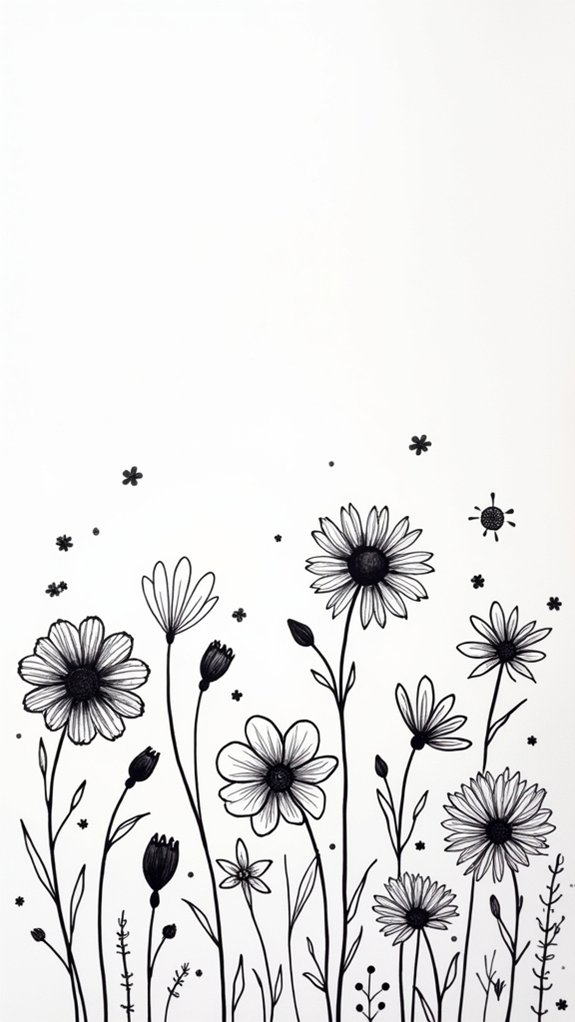
When it comes to drawing simple flower doodles, there’s a world of possibilities packed into just a few lines and shapes.
Starting with a circle center and petals radiating out, anyone can create a flower, but the magic happens when experimenting with creative petal designs. Want petals that look pointy like dragon teeth? Go for it! Prefer puffy, rounded petals? Those work too.
Add dots or stripes inside each petal—these easy floral texture techniques bring doodles to life with surprising depth. Of course, no doodle garden is complete without vibrant color combinations. Mixing pastel pinks, bold yellows, or even neon blues can make each flower pop right off the page.
Combine a bunch, and suddenly, you’ve created a bouquet bursting with personality!
Easy Mountain Sketch
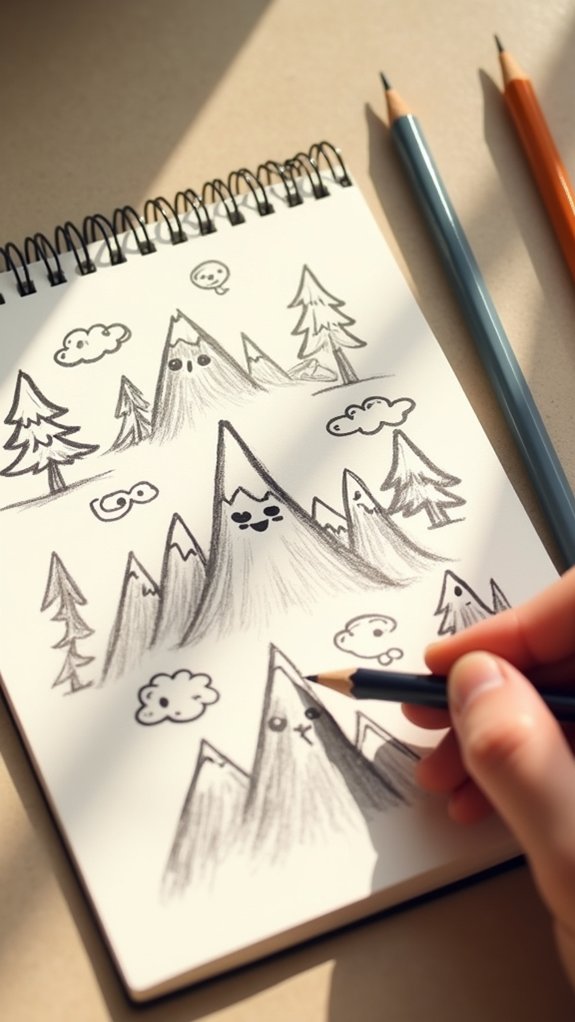
A handful of wavy triangles can reveal a whole world of mountain sketches—seriously, it’s easier than acing a pop quiz. By starting with simple triangle-like peaks, anyone can create a cool range with plenty of mountain textures. Don’t just stick with perfect shapes, though! Try different peak variations—some tall, some chunky, others squished—to add personality. Divide each mountain with a wavy line for depth, then grab a thick marker for outlines and a thinner pen for those pro-level shading techniques. Shade one side with tightly packed lines, and leave the other side lighter for a fun 3D effect. Hop into practicing by checking out the table below for quick tips:
| Step | Tool Needed | Pro Tip |
|---|---|---|
| Outline Peaks | Thick Marker | Mix peak variations |
| Add Valleys | Thin Pen | Use wavy triangles |
| Divide Sides | Thin Pen | Create mountain textures |
| Shade Dark Side | Thin Pen | Tight shading lines |
| Shade Light Side | Thin Pen | Leave space between lines |
Quick Rose Drawing
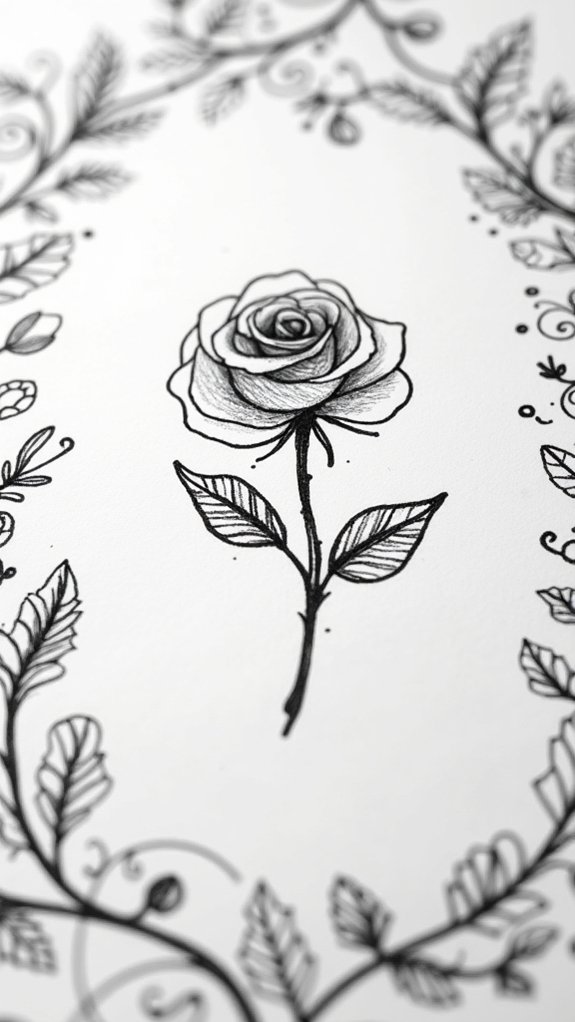
Drawing a quick rose might sound tricky, but it’s actually just a series of simple steps, almost like stacking pancakes—just with more petals and fewer breakfast smells.
Anyone can start with a small circle, then build up layers of petals, and with a few tips for making each petal look unique, the sketch really comes alive.
Get ready to learn the secrets of making your rose stand out, even if your last masterpiece was a stick figure!
Simple Step-by-Step Guide
Every awesome rose doodle starts with just a tiny circle smack in the center of the page—that’s the secret spot where all the petal magic begins!
From there, it’s time to flex those creative doodle techniques. Sketching basics come in handy: gently draw small, overlapping petals around your circle, making sure they look like they’re giving the center a big, flowery hug.
As you move outward, let the petals get bigger and messier—because roses aren’t perfect, and that’s why they’re cool!
Exploring line art means experimenting with thin, curvy lines to mark veins or add texture to each petal. If you’re feeling extra creative, toss in a few leaves at the base.
Voilà, you’ve just drawn a lively rose using easy steps!
Tips for Unique Petals
Just when that rose doodle is starting to take shape, there’s a seriously fun way to blast past boring, common petals—by switching things up! Instead of perfect ovals, think crazy petal shapes—some big, some skinny, some super curvy.
Overlapping lines make each layer pop, and hey, a little messiness adds charm! For extra flair, add curling edges or a random twist to a petal (roses aren’t afraid to be dramatic). Break out that thin pen to draw delicate veins; those details boost realism in a snap.
Don’t just stick to red, either. Try color blending with pinks, purples, or totally wild shades—blue rose? Why not! Mixing colors makes your rose stand out, and it’s way more fun than following the rules.
Dripping Paint Lines
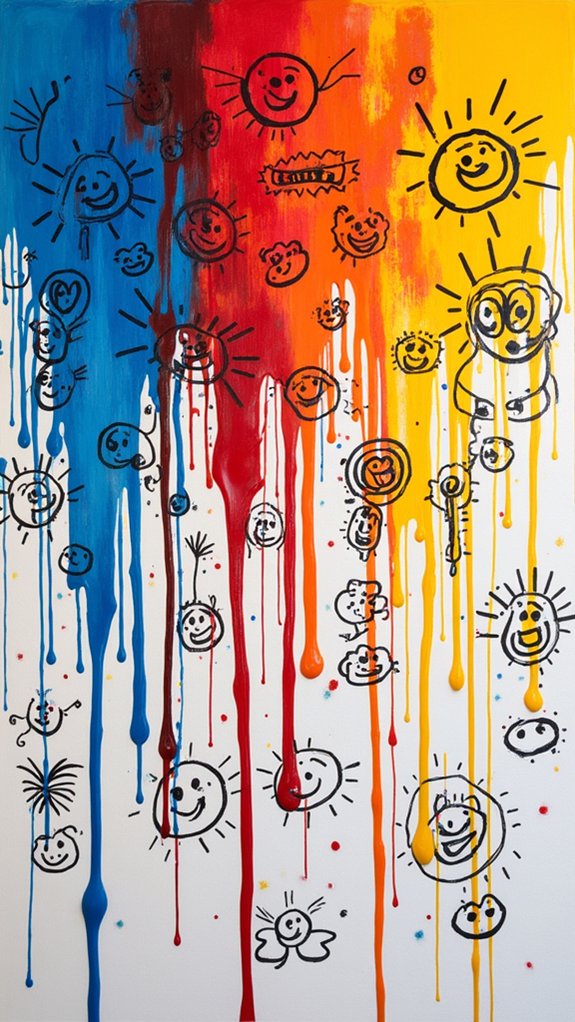
There’s something weirdly satisfying about the look of paint dripping down a surface, almost like it can’t decide if it wants to stay put or race to the bottom.
Dripping paint lines are perfect for adding a splash of drama to any doodle page, and they’re super simple to try. Start with a wide marker to sketch out bold, curvy lines that look like they’re oozing with attitude.
For extra detail, grab a thinner marker and add little “mini-drips” inside—kind of like secret puddles. Creative color combinations make these lines pop, so don’t hold back—try wild pairings or soft gradients using layering techniques.
You can even create playful patterns by staggering the drips or making them squiggle. Imagine the possibilities!
Rainbow Wave Patterns
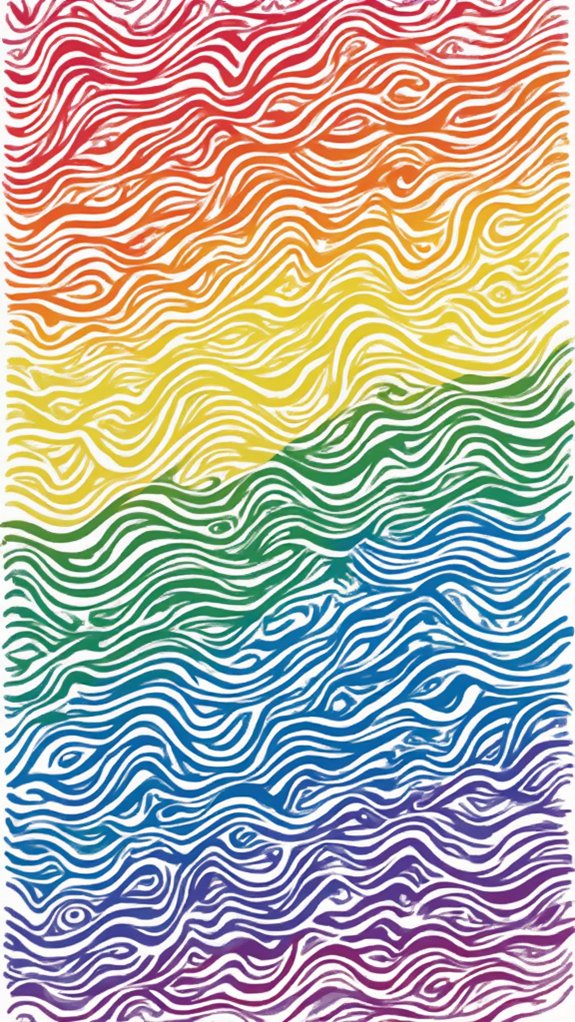
Rainbow wave patterns bring instant energy to any doodle page, almost like a burst of sunshine after a rainy day. Using rainbow color theory, artists can let each wavy line sing by alternating red, orange, yellow, green, blue, and violet.
Wave pattern techniques make it easy—draw wild, overlapping squiggles that can curve up or swoop downward. The real fun starts when doodle texture variations enter the mix. Fill sections with stripes, swirls, or goofy polka dots for extra texture and depth. Some lines thick, some lines thin—it all adds up to something lively and totally unique.
Combine upside-down rainbows with right-side-up ones for an even more playful look. Suddenly, it’s not just doodling, it’s creating a little rainbow party!
Wagon Wheel Circles
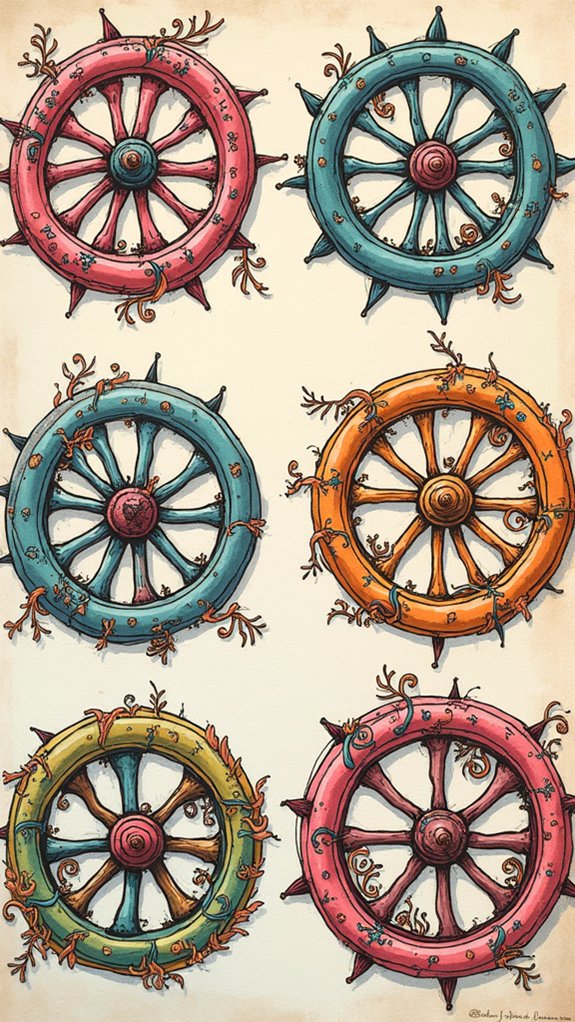
After all the zippy action of rainbow wave patterns, sometimes a doodle page needs something with a little structure—and that’s where wagon wheel circles roll in.
Starting with one big circle, artists can set a dot right in the middle, then experiment with different spoke arrangement ideas by drawing lines from the center to the edges.
Want to try more? Create wagon wheel variations by changing the circle sizes and placing them randomly around the page. This gives the whole sketch a fun, bouncy vibe—as if a parade of wheels is about to stretch across the paper!
There’s plenty of room for cool wheel design techniques, too, like coloring segments or filling spokes with stripes and polka dots. Let creativity spin wild!
Cow Print Blobs
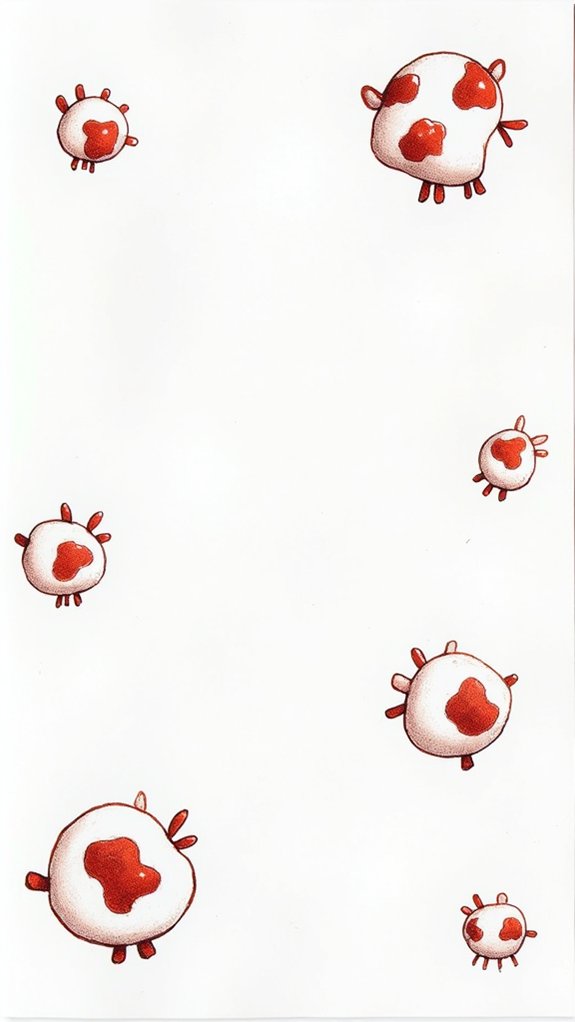
Blobs of all shapes and sizes take center stage in cow print blobs, a doodle style that’s as quirky as it is easy. If you like drawing random shapes, this is your playground!
Creating cow print variations starts with sketching wild, irregular blobs—think of the craziest amoebas you can dream up. Want even more fun? Use blob shape techniques to nest smaller blobs inside larger ones, turning your doodle into a visual puzzle.
For that finishing touch, background coloring tips come in handy: fill in the area around the blobs instead of the blobs themselves. Suddenly, you’ve got a reversed cow print! This trick makes your patterns pop and can fill any empty spot on your page with some seriously cool abstract art.
Starry Sky Motif
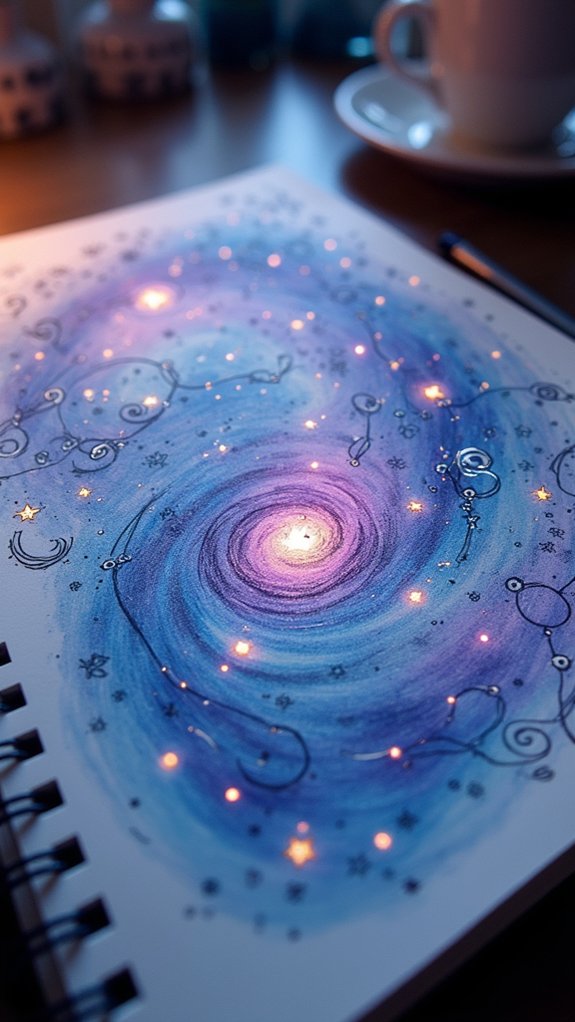
Who says the fun has to stay on the ground? The starry sky motif invites doodlers to float into a world of moonlit serenity, dotted with whimsical stars and fluffy clouds.
This dreamy design is not just pretty to look at—it’s seriously soothing, too. Here’s how to level up those quick sketches and make your night sky shine:
- Draw a crescent moon nestled among fluffy clouds for instant calm vibes.
- Mix up the sizes of your whimsical stars and clouds to create depth and drama.
- Sprinkle in sparkles or shooting stars—just a few lines for pure magic.
- Remember, the starry sky motif is simple, so everyone can join the fun, no experience needed!
Want your drawings to feel peaceful and magical? Try this motif tonight!
Chubby Blackbird Sketch
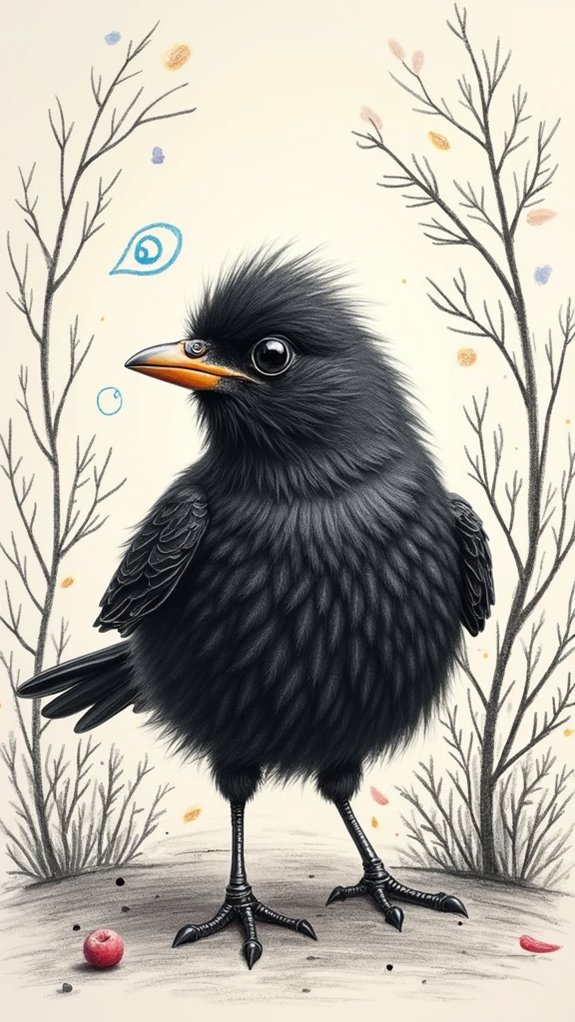
A chubby blackbird doodle brings instant charm to any page, and it’s honestly one of the easiest—and cutest—sketches out there.
Starting with a big round body and topping it off with a tiny head amps up the cuteness. To show off blackbird personality traits like playfulness or mischief, adding wide, expressive eyes, a teeny beak, and two swooping wings works wonders.
Want your blackbird to stand out? Try using wild doodle color choices—go classic black, or maybe toss in some bright blues or wild yellows if you’re feeling bold.
For sketching techniques, mix in simple patterns like spots or stripes for an extra pop. Quick, quirky, and totally fun, this blackbird is perfect for spicing up your notes or journal!
Frequently Asked Questions
How to Draw an Easy Doodle?
To draw an easy doodle, one might begin with simple shapes, layering circles or squares. Adding playful patterns and whimsical creatures, such as smiling animals, creates visual interest. Light pencil outlines help before committing to inked lines.
What Should a 12 Year Old Draw When Bored?
When considering what to draw when bored, a 12-year-old might enjoy sketching cartoon characters, exploring nature scenes with trees or animals, or inventing abstract patterns. These options encourage creativity, self-expression, and skill development through imaginative drawing.
What Are Quick Draw Doodles?
Quick draw doodles are spontaneous, simple sketches created rapidly, often utilizing various doodle techniques and sketching styles. Artists draw inspiration from daily life, imagination, or patterns, making these exercises effective for exploring creativity and improving artistic confidence.
What to Draw 100 Ideas?
The current question seeks a list of 100 drawing subjects. Utilizing doodle prompts, sketch themes, and creative exercises, artists can explore a wide variety of imagery, including objects, animals, nature elements, food, patterns, and imaginative scenes.
How to Doodle When Bored?
When boredom arises, individuals can combat it by exploring various doodle techniques and seeking creative prompts. These boredom busters promote spontaneous creativity, offering relaxation and focus. Engaging with online communities inspires fresh approaches and keeps doodling sessions stimulating.
Conclusion
So, the next time someone claims doodling is just for daydreamers, they clearly haven’t seen these awesome ideas. Whether it’s swirling spirals, funky cow spots, or chubby little birds, there’s a sketch here that’ll make anyone’s notebook way cooler. Trying new doodles isn’t just fun—it’s actually super relaxing, too. So, grab a pen, pick a design, and get drawing. Who knows? You might surprise yourself and end up with a mini masterpiece right in your math notebook.

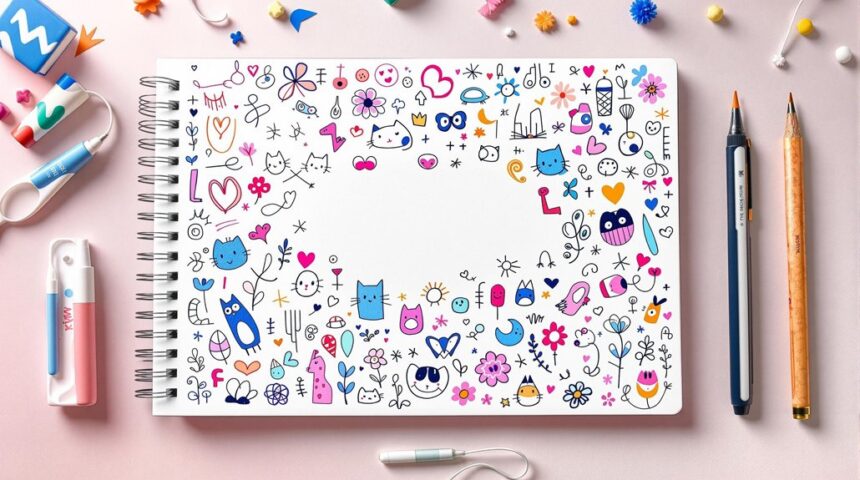
Leave a Reply